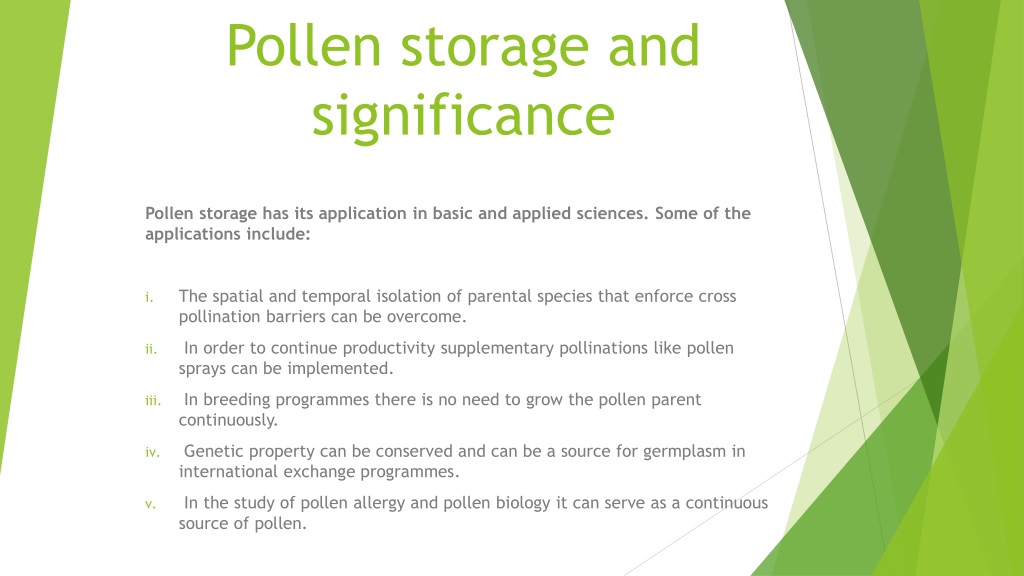

0 likes | 22 Vues
Pollen storage plays a vital role in various scientific and breeding applications, such as overcoming cross-pollination barriers, conserving genetic diversity, studying pollen biology, and improving breeding efficiency. Different methods like low-temperature storage, organic solvent storage, freeze or vacuum drying, and cryopreservation ensure pollen viability. Tests like pollen germination and viability tests help assess stored pollen quality for successful breeding programs.

E N D
Pollen storage and significance Pollen storage has its application in basic and applied sciences. Some of the applications include: The spatial and temporal isolation of parental species that enforce cross pollination barriers can be overcome. i. In order to continue productivity supplementary pollinations like pollen sprays can be implemented. ii. In breeding programmes there is no need to grow the pollen parent continuously. iii. Genetic property can be conserved and can be a source for germplasm in international exchange programmes. iv. In the study of pollen allergy and pollen biology it can serve as a continuous source of pollen. v.
Significance of pollen storage (contd) 5. Exotic nuclear genetic diversity can be easily received and exchanged through pollen, thereby eliminating the need to go through a long juvenile phase, common in most fruit trees to produce pollen for hybridization at a desired location. Thus, stored pollen can be used to improve breeding efficiency. 6. Fruit tree pollen is generally required to be stored for controlled crossings, either to achieve a desired breeding objective, or to overcome a constraint involved in commercial fruit production. 7. Pollen storage has come to the rescue, where stored pollen indexed as viable can be used in crossing with the desired female clone so as to accomplish the breeding objective
Conditions required for pollen storage Low Temperature Low relative humidity Dehydrating agents like silica gel Lycopodium powder to avoid sticking
Pollen Storage in Organic Solvent Iwanami and Nakamura (1972) first demonstrated the use of different organic solvents in pollen storage. The organic solvents include benzene, petroleum, diethyl ether, acetone, chloroform, etc., whose efficiency varies greatly for different plant species.
Freeze or Vacuum Drying (lyophilization) Pollen of different taxa especially the desiccation-tolerant pollen can be successfully preserved for a long period of time by freeze or vacuum dying method. Freeze-drying involves the rapid freezing of pollen to sub-zero temperature of -60° C or -80° C using inert gas helium or nitrogen, and then the gradual removable of water under vacuum sublimation In vacuum drying the pollens are directly exposed to a vacuum and simultaneous cooling. The moisture is later withdrawn by evaporative cooling. In number of taxa when freeze drying is combined with lyophilization then storage and viability of pollen has been found to be very effective.
Cryopreservation by deep freezing Long term preservation can also be done by ultra low temperature, ranging between -70° C and -196° C. Since the first half of 1950s, several studies have been conducted on the cryopreservation of pollen. A reduction in the pollen water content below a threshold level before low temperature exposure seems to be important for achieving viability. Thus partially dehydrated pollen possesses less freezable water and can survive deep freezing.
Pollen Viability tests Seed set or ovule development after pollination Pollen germination and pollen tube growth In vitro pollen germination Tetrazolium chloride test Fluorescein diacetate test NMR method
Tetrazolium test 2,3,5-triphenyltetrazolium chloride is used for staining 0.5% to 10% solution of the salt is prepared in 10% sucrose solution. Sucrose helps by preventing bursting of pollen tube. pH is maintained at 5.8 with 0.15 M Tris HCl. To test viability, pollen are dispersed in a drop of the medium on a slide and immediately covered with a cover glass to exclude oxygen which inhibits reduction of the dye. The slide is placed in a petri plate with moist filter paper and incubated in dark at 35 to 60 degree C for 30 minutes to 3 hrs. The viable pollen grains turn red because of reduction of the dye to form red coloured pigment Formazon.
Fluorescein Diacetate Test It is the most reliable test The test is dependent on two cellular parameters: Effectiveness of plasma membrane Presence of nonspecific esterases in pollen cytoplasm. Stock solution of FDA is prepared (2mg/ml acetone) Few drops of stock solution are added to 10 – 20% sucrose solution. A few pollen are dispersed in this solution and FCR is allowed to proceed for 10 minutes in a petri plate lined with moist filter paper. The suspension is then covered with cover glass and viewed under FM. The pollen grains with bright fluorescence are scored viable.
Principle of FDA test In the viable pollen the non fluorescent pollen compound FDR enters through the membrane. In the cytoplasm it is cleaved by non-specific esterases to release the fluorescent and polar compound fluorescein which can not move across plasma membrane and therefore accumulates in pollen cytoplasm to give fluorescence.
Pollen viability test with FDA in Arabidopsis
NMR method This method is non destructive. The sample can be recovered for experiment. comparative levels of free and bound water are determined part of passes from bound to free state upon loosing viability due to aging
References https://www.biologydiscussion.com/palynology/pollen-storage-in-plants- methods-and-significance/64594#:~:text=i.,- Effects%20of%20Temperature&text=Pollen%20grains%20can%20be%20suitably% 20stored%20in%20glass%20or%20polythene,to%20maintain%20required%20relati ve%20humidity.